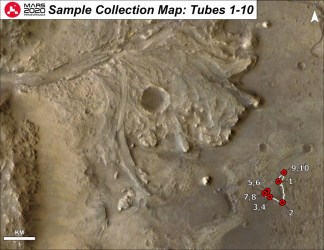One of the Mars 2020 science objectives is to collect and cache specimens for potential future return to Earth. Documentation of the collection process and the samples themselves is an important component of the process. The Analyst's Notebook will include sample collection documentation and data included in the NASA PDS archive. Until the archive has been peer reviewed and released, initial reports and simple descriptions of the samples is included.
The Returned Sample Science Archive identifies and documents information related to remote sensing and contact science observations of targets that are drilled and for which samples are cached on the surface. The archive provides scientific context for the samples, and documents what was done during drilling, including the exact location, appearance of the target before and after drilling, and measurements of currents and other engineering parameters associated with drilling. The archive also documents the locations and physical characteristics of cache points for future retrieval.
An overview table of acquired samples in available from the Notebook's Mission tab. Information about individual samples is accessed from the Notebook's Sample science tab.
Initial reports
Initial reports are created by the Mars 2020 science team for each sample collection. Refer to the initial reports for a thorough and detailed description, context, and preliminary scientific assessment of each collected sample.
The Initial Reports introduction is common to all samples.
Individual samples
Details about each collected sample can be accessed from the Sample science tab:
-
Acquisition date and location, including a brief lithology statement.
-
Images of the sample in the collection tube and the related abrasion patch.
-
Pre-release reports. These reports are provided by the Perseverance science team. They have not been peer reviewed nor are part of the mission archive. A formal archive of sample dossier material is being prepared by the team.
Sample collection map
Three Forks Depot
An initial set of 10 samples was placed on the surface of Jezero Crater near the end of the prime mission to serve as a backup in case the primary set of samples cached within the rover are unable to be retrieved for return to Earth. The location is referred to as the Three Forks Depot.
see also
- Sample science Initial Reports
- Three Forks Depot
- About the Mars 2020 mission
- The PDS Geosciences Node Mars 2020 archive page.
- The Mars 2020 mission web site.
- The NASA home page.
